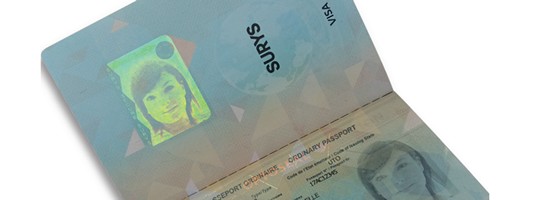
Passport security trends: a revolution on the third page
Since the September 11th attacks, tremendous efforts have been made to protect travel documents. With an urge to better guard borders, governments have invested in passports protection. Logically, the focus has been on the security of the data page, the place where most forgeries happen. But what about security on other pages?
A number of security features has piled up over the years: from ultraviolet to optical variable ink, from clear window to personalized perforation, from 2nd portrait to tactile elements, without forgetting the exponential technology leaps of DOVIDs.
Right now, the amount of security features embedded in a data page is significant and that is the way it should be. At the same time, this weakens the security of the rest of the booklet. Indeed, if counterfeiters can get hold a data page or find a way to forge it, the whole document is in danger. In a certain way, the strength of a very secured data page has become its Achilles heel.
This is even more relevant when it comes to a Polycarbonate data page. The concept of such passports requires the data page and the booklet being produced separately and being put together only at the last stage of the manufacturing process. These kinds of data pages become an outside element of the booklet.
Due to these reasons, we are witnessing an increasing demand to secure another page of the passport booklet. The obvious choice is the 3rd page, or the so-called observation page. In the recent years some countries have been applying standard security features on the 3rd page: optical variable ink, holographic laminates, or 2nd or 3rd portraits. The latest is actually very pertinent. The photograph on the data page being the most forged element in a passport pushes governments to duplicate the picture on another place. A portrait on the 3rd page enables border controllers to easily compare this picture with the one on the data page. This creates a link between the data page and the rest of the booklet, as stated necessary earlier.
But one problem remains: how to create a forge-proof portrait on the data page? If counterfeiters are able to forge the main portrait, they can also do it with the 3rd page portrait. To resolve this issue, SURYS’ engineers have labored a product that is now mature: the HoloID™.
The HoloID™ is a personalized hologram, i.e. a portrait based on holographic characteristics, thus extremely difficult to forge. To achieve this, we use a photopolymer patch on which a varnish is applied at the stage of personalization. The varnish swallows the photopolymer at different depths depending on the wavelength used for each “pixel”. By controlling the wavelength of the varnish applied, the photopolymer can be controlled to make it reveal the desired portrait. This portrait will be exactly the same than the one used on the data page, making it easy for controllers to confirm that the document is genuine.
The HoloID™ has been crafted with an important goal in mind: increase the security of a passport booklet without increasing the burden on the personalization side. Therefore, SURYS has developed modules based on simple inkjet printer engines to ensure a smooth personalization system, centralized or decentralized, and to keep the costs low.
There is a growing need to secure the 3rd page or observation page of a passport booklet. To respond to this need, HoloID™ solution offers:
– A very strong level 1 security feature
– A link between the data page and the 3rd page thanks to the common portrait
– A simple personalization add-on to keep machine investment low
Alexandre Benjamin & Serge Wsevolojskoy
